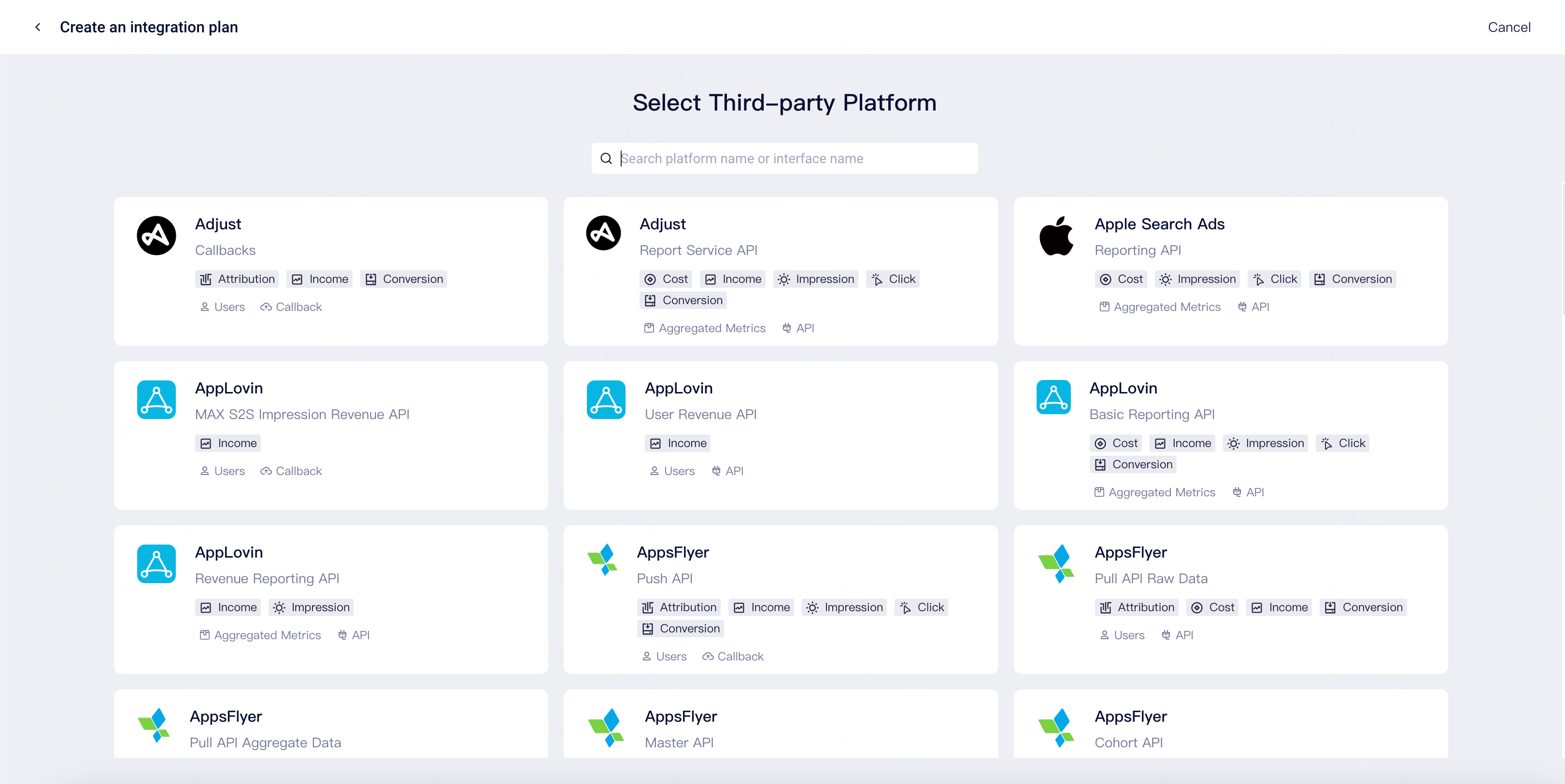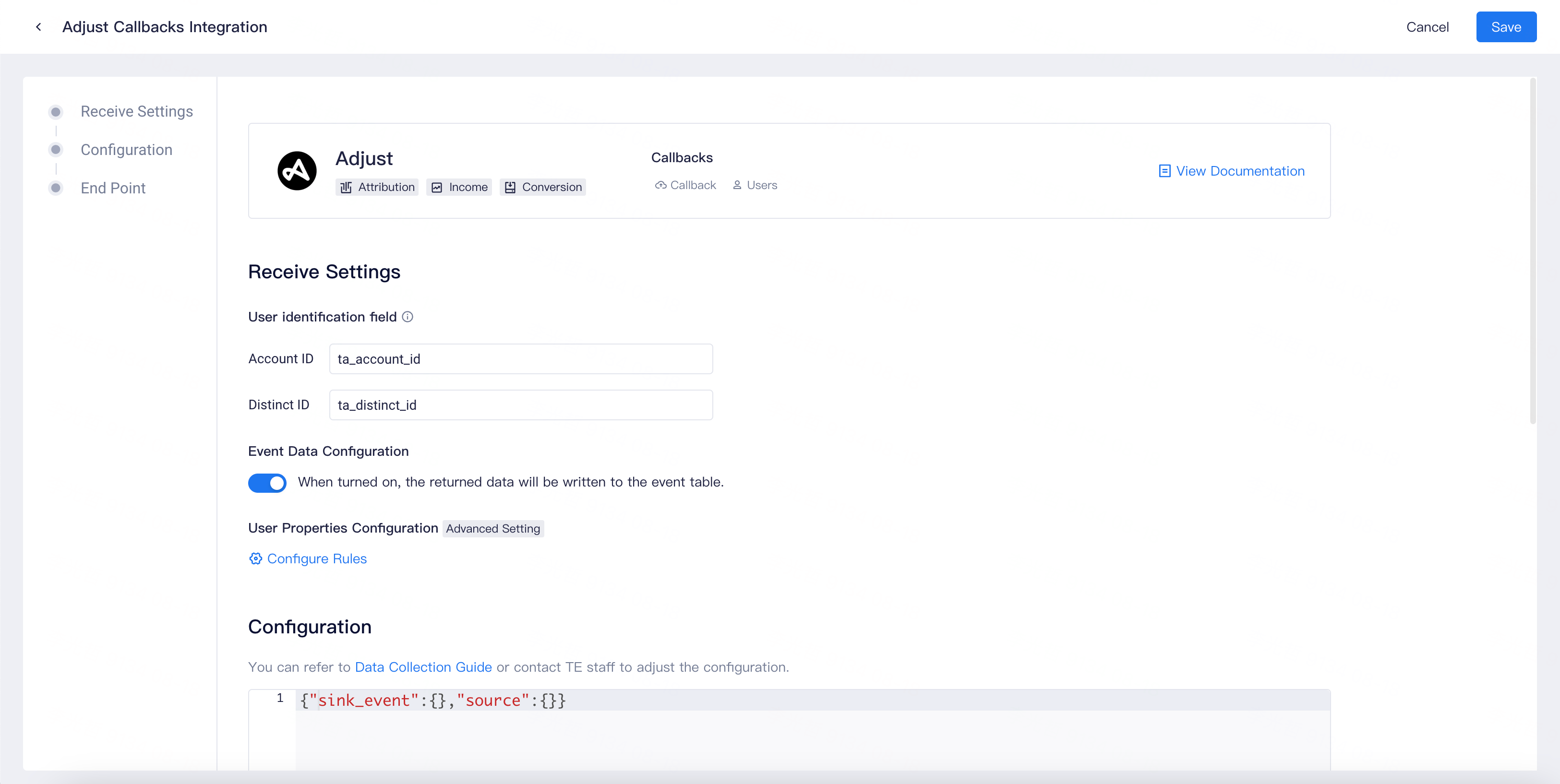# Third-party Integration
The third-party integration module provides integration capabilities for a range of third-party ad platforms, allowing you to synchronize the delivery and monetization data of these platforms with the TE system. This article will focus on the core features of the pages in the third-party integration module and the basic concepts of the module. If you want to learn about the specific integration methods for each platform, you can refer to the subpages of this page.
# Third-Party Integration Homepage
The homepage of the third-party integration module displays the currently supported integration schemes and their basic information, including the name of the integration scheme, the platforms and interface information, the current integration status, the creator of the scheme, and the last modification time, etc.
Please note that the new version has added a limit on the number of third-party integration configurations. The number of configurations for third-party integrations that can exist in a cluster cannot exceed this limit. If the limit is reached, you can release configuration slots by deleting unnecessary schemes.
WARNING
The system scheme limit is determined by the scale of your cluster. If you need to adjust the limit, please contact TE staff for assistance.
You can click the "Create Scheme" button in the upper right corner to enter the scheme selection page and choose the data interfaces currently supported for integration. You can also click the edit button inside the card to enter the scheme editing page and modify the configuration of the integration scheme.

# Solutions Page
The Solutions page displays basic information about all supported integration solutions. You can choose the integration method you need and click on the card to enter the editing page for that integration method.
The solutions page also provides a search function, allowing you to search for platforms that need to access data by their platform names.

# Configuration Page

When you click the edit button on the Third-Party Integration homepage or click on an integration method card on the Solution Selection page, you will be directed to the configuration page for the third-party integration. The screenshot above shows the configuration page for the Adjust Real-Time Callback solution. As the data logic varies among different platforms, the configuration pages for each platform may differ as well.
The configuration page displays basic information about the selected solution, allowing you to understand the data types supported by that solution. Additionally, you can click on the "Integration Documentation" link to access the integration documentation for that solution.
Furthermore, you can adjust the data integration rules on the configuration page. As shown in the screenshot above, you can modify the user identification field selected for third-party data storage, choose whether to store events, and decide whether to store user attributes. If you wish to make more in-depth adjustments, you can modify the JSON in the "Integration Configuration" section to control the specific configuration for data retrieval. To learn about the configuration methods for each platform, you can refer to the integration documentation for the respective platform's interface.
# Data processing logic
TE currently supports integration solutions for over 40 third-party platforms. Each solution provides data with different structures and meanings. This section will primarily introduce the classification of data interfaces for third-party platforms, data types, and the standardized services provided by the TE system to eliminate differences between platforms.
# 4.1 Interface classification
The function of data provided by a third-party platform can be referred to as a data interface, which can be classified from two dimensions: granularity and integration type.
Data granularity
- User level: Each piece of data represents a user's exposure, click, or installation behavior, which the TE system directly converts into TE events or user data.
- Aggregate metrics: Each piece of data contains information on analysis dimensions and various metrics, but not of any specific user. TE records this data in the form of an event for a virtual user.
Understanding the difference between the two data granularities using ad impressions:
- User-level ad impression data records user information and ad information. Each piece of data represents an exposure, and the total volume of exposure data (or the number of events) is the impression volume.
- Aggregate-metrics data only has one or several pieces of data. Ad impression volume is just one metric field in each piece of data. Other metrics, such as ad clicks, conversions, and costs, are also included in each piece of data, as well as ad dimension fields, such as ad plans and ad groups. Each piece of data represents the metric situation of the finest analysis dimension, such as the click-through rate, impression rate, and total cost of an ad in a specific ad plan.
Generally, user-level data can be used in various analysis models like other events, while aggregate-metric data can only be used in event models, retention models (mainly used to calculate ROI), and SQL queries because it is not actual user-generated behavior.
Integration type
- Callback: Callback refers to the third-party platform continuously returning their raw data to the TE system in near-real-time. All callback-type integration solutions supported by the TE system currently have user-level data granularity. In some cases, this is also referred to as Push API.
- API: API refers to the data-pulling interface provided by third-party platforms. The TE system sends data-pulling requests to third-party platforms according to the configuration, and data will only be transmitted after the pulling request passes. Most of the API-type integration solutions supported by the TE system currently have aggregate-metric data granularity, and a few have user-level data granularity. In some cases, this is also referred to as Pull API.
Integration type affects the real-time nature of data. Callback data is essentially real-time, while API data has a certain delay. In addition, the configuration method of integration type is also different: the main configuration of callback data is on the third-party platform, and you only need to copy the callback address in the TE system; API data requires configuring Token, time range, pulling frequency, metrics, dimensions, and other information in the TE system.
# 4.2 Data Types
Although data from different platforms may differ, the most critical data for advertising and monetization can be classified into the following six types. On the third-party integration page, you can see the data types supported by each platform.
| Data Types | Meaning |
|---|---|
| Attribution | Ad source information attributed to a user after attribution. Attribution data can only be at the user level and can be seen in user installation events and user attributes. |
| Cost | The cost of buying traffic, which may be aggregated or at the user level. |
| Revenue | Revenue generated through monetized ads, which may be aggregated or at the user level for each monetized ad. |
| Impression | The number of times a bought or monetized ad is displayed. This may be aggregated or at the ad level. |
| Click | The number of clicks on a bought or monetized ad. This may be aggregated or at the ad level. |
| Conversion | Non-organic user behavior within a game or app that leads to a conversion. For most platforms, conversion refers to user installs. This may be aggregated or at the user level for each conversion event. |
# 4.3 Field Standardization
To facilitate the analysis and integration of advertising data from different platforms, the TE system provides field standardization functionality. According to preset logic, the TE system writes the core fields in the received data into an object field called "te_ads_object", thus achieving the function of unifying core fields across platforms. TE system supports automatic field standardization for most platforms it integrates with.
| Standardized Fields | Meaning |
|---|---|
| te_ads_object.ad_account_id | Advertising Account ID |
| te_ads_object.campaign_name | Advertising Campaign Name |
| te_ads_object.campaign_id | Advertising Campaign ID |
| te_ads_object.ad_group_name | Ad Group Name - Unit name for monetized ads |
| te_ads_object.ad_group_id | Ad Group ID - Unit ID for monetized ads |
| te_ads_object.ad_name | Ad Name |
| te_ads_object.ad_id | Ad ID |
| te_ads_object.placement | Ad Placement |
| te_ads_object.media_source | Media or Monetization Channel |
| te_ads_object.app_id | App ID |
| te_ads_object.app_name | App Name |
| te_ads_object.platform | Platform - For example, Android, iOS, etc. |
| te_ads_object.country | Country Code |
| te_ads_object.currency | Currency for cost or revenue |
| te_ads_object.impressions | Impressions |
| te_ads_object.clicks | Clicks |
| te_ads_object.installs | Conversions (installations) |
| te_ads_object.cost | Cost of buying traffic |
| te_ads_object.revenue | Revenue generated through monetized ads |
